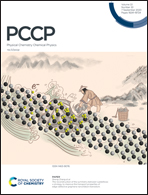Origin of photocatalytic activity enhancement in Pd/Pt-deposited anatase N-TiO2 – experimental insights and DFT study of the (001) surface†
Abstract
In pursuit of the ideal photocatalyst, cheap and stable semiconductor TiO2 is considered to be a good choice if one is able to reduce its band gap and decrease the recombination rate of charge carriers. The approach that offers such improvements for energy conversion applications is the modification of TiO2 with nitrogen and noble metals. However, the origin of these improvements and possibilities for further design of single-atom catalysts are not always straightforward. To shed light on the atomic-scale picture, we modeled the nitrogen-doped (001) anatase TiO2 surface as a support for palladium and platinum single-atom deposition. The thermodynamics of various synthesis routes for Pd/Pt deposition and nitrogen doping is considered based on density functional theory (DFT)-calculated energies, highlighting the effect of nitrogen doping on metal dimer formation and metal–support interaction. XPS analysis of the valence band of the modified TiO2 nanocrystals, and the calculated charge transfer and electronic structure of single-atom catalysts supported on the (001) anatase TiO2 surface provide an insight into modifications occurring in the valence zone of TiO2 due to nitrogen doping and Pd/Pt deposition at the surface. DFT results also show that substitutional nitrogen doping significantly increases metal–support interaction, while interstitial nitrogen doping promotes only Pt–support interaction.



 Please wait while we load your content...
Please wait while we load your content...